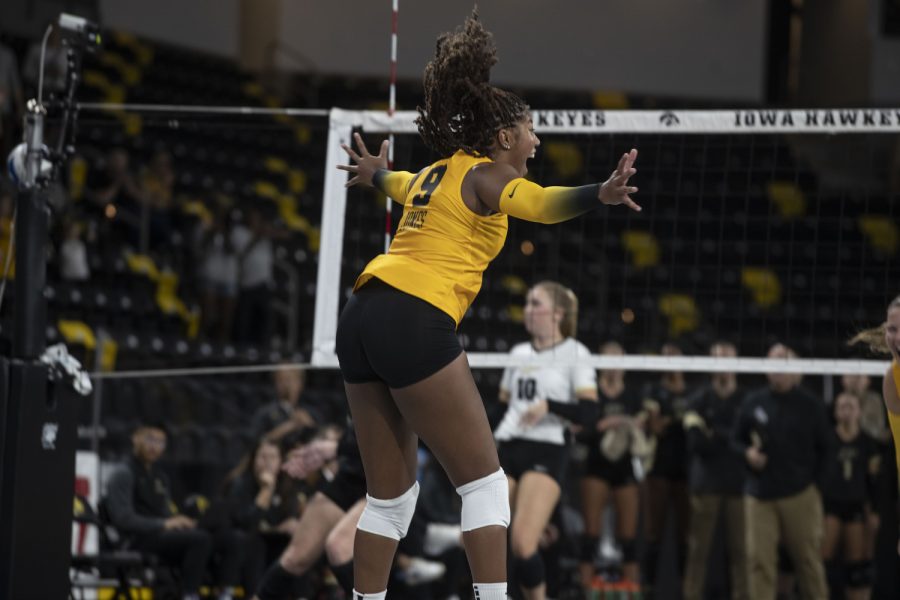The stomping is effective, but it’s not correct.
On a balmy fall day, Iowa freshman Annemie Smith tosses the hammer outside the Cretzmeyer Track in Coralville. While the nine-pound steel ball and chain is still cutting through the atmosphere as fast as a quarterback’s Hail Mary, the technical aspects of the throw that released it are not refined.
"It’s three turns, but it should be one consecutive motion," observes Iowa throwing coach Scott Cappos.
The freshman’s steps also seem forceful in contrast to the apparent daintiness of the 240-pound men throwing beside her.
And then, there’s her neck.
"The first thing that moves [when I start my throw] is my head," Smith said. "I’m not supposed to do that. Coach even made a joke that he’s going to bring a neck brace to practice."
Smith’s throws feel coarse compared with the other three Hawkeyes tossing that day, but her hammer is going nearly as far as those of the two men in the rotation — although they use a heavier weight.
In spite of the technical shortcomings, though, she could become Iowa’s best hammer thrower ever. And in a sport with little recognition, a competitor from a country with little history in the sport has the potential to be the next big thrower in the Big Ten.
Hammer throwing: a misnomer
The sport of hammer consists of an athlete spinning around before chucking what looks more like a flail than any type of hammer. The ball on the end of a steel chain weighs 16 pounds for men and just under nine pounds for women; the hammer’s world-record throws traveled 86.74 meters (284 feet, 7 inches) from a man’s hand and 79.42 meters (260 feet 7 inches) from a woman’s.
The field event has disappeared in America in recent years. Once contested in more than 10 states across the country, Rhode Island is now the only state that sanctions the hammer at its public high-school state track and field meets. The last American to win an Olympic gold medal in the sport was in 1956.
Female hammer throwers are even less heralded. While the event was available to men in the 1900 Olympics, women waited until 2000 in Sydney for the chance at a gold medal.
Maybe, then, it’s fitting that America didn’t produce Iowa’s newest throwing product.
A jumps coach and a computer
Smith was introduced to the sport in 2008 in her native land of South Africa. Her first coach, whose name was withheld because of an ongoing battle with alcoholism, was experienced but verbally abusive. After she had three illegal throws in her first-ever national competition, she said he turned to publicly discouraging her.
"Sometimes, he would tell people I don’t have talent or I’m not national material," Smith said.
She eventually reached the point where she decided she needed a new coach — one with a different approach.
She enlisted her old high-jump instructor, Jacques Woolfardt, to be her new coach and to help train her athleticism, not her throwing. He had never worked with a hammer thrower before but quickly immersed himself in practice along with Smith, teaching the concepts of success while letting her discover the fundamentals.
But she had another coach that could teach her 24 hours-per-day: YouTube. She took to the Internet to find videos on the basics of throwing, and the 18-year-old said she actually preferred teaching herself.
"I’m a very visual person," she said. "It’s easier for me to learn when I see it, instead of when someone tells me."
It’s a common strategy, because the sport has become minor, because now the minority is online.
But Smith’s individual perceptiveness cannot be understated. While watching a collection of throws from the 1988 Olympics in Seoul, South Korea, Smith pointed out two fundamentals that the Soviet Union’s Yuriy Sedykh perfectly executed in his silver-medal toss.
"His feet aren’t as closed as all the others. If your feet are closed, you can’t really sit down," said Smith, pointing to Sedykh’s thighs, which were nearly parallel with the ground during his turns.
While videos cared for Smith’s technique, Woolfardt cared for her mind and coached her the only way he knew how: He encouraged her.
"He’s been playing a big role in how I think," Smith said. "The No. 30 in the world can be No. 1, but it’s a matter of your mind."
‘She’s good’
Even though he wasn’t entrenched in the sport yet, Woolfardt knew after just one practice that Smith had unrealized potential.
"The first time I saw her throw, I thought, ‘She’s good,’ " Woolfardt said.
While Smith calls Woolfardt her coach, the pair’s time together is much more casual and equal than the typical instructor-pupil relationship.
He is her friend, valuable more for jokes that lighten a rough practice than correcting her footwork.
But there’s a saying somewhere in between coaching and friendship that changed how Smith approached her new sport.
"Rhythm is the foundation of balance," Woolfardt always told Smith.
An obsession with metrics is common among hammer throwers and coaches. Some see rhythm as part of the rarity that is a perfect throw. Four or five spins — hopefully, all taking the same amount of time — before a fling where fluidity is as important as strength.
"To me, it’s the ultimate combination of power and grace," Bissinger said. "You’re picking up this … hunk of metal and hurling it almost the distance of a football … with the grace of a dancer or a ballerina."
For Smith, though, the obsession originates at a more aesthetic level.
"I have this obsession with rhythm," she admitted. "[I like to] listen to someone’s feet … If someone’s feet are in rhythm, I like it very much."
Smith’s aural pleasure made her learning simpler — and the simpler it was, the better her results became. She went from her computer chair to national prominence in fewer than two years, winning South Africa’s junior national hammer-throw competition in 2010 and 2011.
Her top throw of 57.13 meters was a national record for her age group. The next highest distance was 50.27.
Coming to Iowa
Scott Cappos learned about Smith after receiving a tip from a former South African athlete, and Iowa’s assistant coach in charge of throws eventually persuaded the young athlete that her future would be best secured with the Hawkeyes.
Cappos is in his 13th season at Iowa. A former Big Ten shot-put champion at Indiana, he has taught the fundamentals to All-Big Ten hammer throwers in nine of the last 11 years. Smith was self-taught — or virtually taught, at least — and hadn’t had a proper throwing practice with a proper throwing coach in more than a year when she stepped on the Cretzmeyer Track.
Practices with Woolfardt were about athleticism. The jumps coach had her run stairs or flip truck tires, but the two didn’t know the inside secrets to improving hammer form.
Now, she does drills — a novel idea for one of the world’s best young throwers. And while her past hasn’t stunted her distances in competition, the self-teachings can be evident during practice.
"She does some things unconventionally," Cappos said.
The potential
The future is accelerated for Smith.
South Africa isn’t known for field prowess and in a sport that just isn’t very popular, she will likely have the chance to represent the national squad in numerous Olympics. Hypothetically, Smith could compete for a medal from 2016 to 2024.
"She’s at the level where she can contend for Big Ten championships coming into school as a freshman," Cappos said.
But Smith isn’t even close to her potential.
Now, after a move across the globe, the potential for firsts and university records is tangible.
Iowa has had 16 track and field Olympians in eight Olympics, none of whom have been female. The Hawkeye record for a hammer throw is 59.45 meters, set by former Hawkeye Becca Franklin at the 2007 Musco Twilight meet. Smith hopes to be throwing 60 meters by the spring.
Being surrounded by competition that can keep up with her is almost as big of an adjustment for Smith as switch from speaking Afrikaans to English on a daily basis.
But her mental and physical strength are at an all-time high, and her throws are becoming better every practice. The outdoor track season can’t come soon enough for Iowa’s eager hammer thrower.
"I don’t know if I can handle [the competition] yet," she said. "But I can’t wait."






